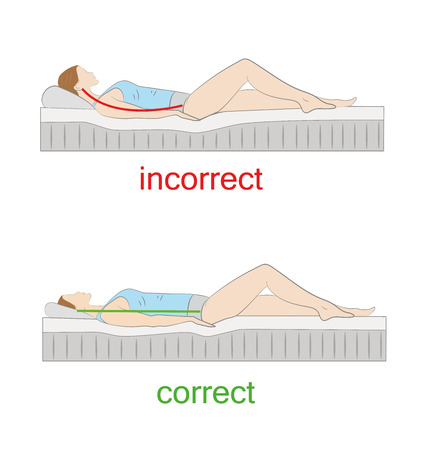This is a guest post contributed by Sandra McElroy of BedtimeFriends.
We often don’t mind our sleeping position, because what’s important is that we get our sleep. However, your position effects on your body and health in multiple ways. If you have a condition or a health problem, there might be a sleeping position that will help you improve it. Read on to learn about the different sleeping positions, their pros and cons, and to see if you should change your sleeping position today.
#1 On Your Back
Among all the sleeping positions, the back seems to have the favor of most sleep experts. However, it’s not the most popular position there is. There are different variations of this position, including the soldier and the starfish. The soldier is performed by lying on your back with your arms on the side, close to the body. On the other hand, the starfish is when your arms are above the head.
Pros
- This position promotes a natural alignment of the head, neck and spine.
- Using this position together with the right mattress and pillow can prevent backaches and neck pains.
- Sleeping on your back doesn’t put your face or your breast against any pressure. Thus, it’s the best position for preventing acceleration of wrinkles and sagging of breasts.
- You can also prevent acid reflux by sleeping on your back since your esophagus is slightly higher than the stomach.
Cons
- This position often aggravates or causes snoring.
- It’s also not good for sleep apnea.
- The starfish variation can cause shoulder pain.
Recommendations
To get the benefits of this position, you will need a mattress that supports a neutral alignment of the head, neck, and spine. It needs to be firm, but also comfortable enough for you to find uncomfortable. A latex mattress or memory foam works well for this position. As for pillow, it shouldn’t be too thick that it strains the neck. Flat pillows or even no pillow work excellently for this position.
In case you don’t have a good mattress, you can also add a flat pillow below your lower back to support your spine. A pillow under your knees will also help.
#2 On Your Side
Based on many surveys, sleeping on the side is the most common position. There are also variations of this position: the log, the yearner, and the fetal position. The log involves sleeping on either your left or right side, with both your arms on your side. If your arms are out in front of you, then you’re in the yearner position. The fetal position is when your body is curled up.
Pros
- Sleeping on your side is also another useful position to help prevent acid reflux.
- This position is the best for those who have sleep apnea because it keeps your air passage open. It also prevents or stops snoring.
- With the right mattress and pillow, this position is also considered good for the spine and neck.
- The fetal position, specifically on the left side, is the best for pregnancy because it promotes circulation between mother and fetus.
Cons
- Since your body and face will be against some pressure, this position can cause wrinkles. It’s also not beneficial for maintaining breast perkiness.
- You might feel some shoulder pain if your arms are in an awkward position.
Recommendations
When sleeping on your side, you will need a mattress that offers adequate support. You want there to be no gaps between you and mattress so you won’t get neck pains and back pains. Additionally, the mattress should be able to support a neutral spine to prevent lower back pain.
For this position, you should get a medium firmness mattress. If it is too firm, it might create a gap that we mentioned. On the other hand, if it is too soft, your spine won’t get the support it needs to be in proper alignment. A mattress topper for side sleepers is popular – it’s an easy fix to correct and incompatible mattress.
For your head, you will need a thick pillow to maintain a neutral horizontal line of the head, neck, and spine. You should also put a pillow on your legs to prevent pressure and downward rotation of your legs.
#3 On Your Stomach
Sleeping on your stomach is the least favorite among sleep experts. It’s easy to see why – it’s difficult for the spine to keep a natural position. It also puts pressure on some joints and muscles of the body, especially the neck. You can sleep facing down with your arms on the side of your body or on the side of your head (also called freefall).
Pros
- This position if good for digestion. It also minimizes or stops snoring.
Cons
- Putting a strain on the neck leads to neck pains. It’s also not very helpful for the back.
- This position is the least likely to help if you want to maintain breast perkiness and prevent wrinkles.
Recommendations
 If you must sleep on your stomach, you should look for a flat pillow so it won’t over extend your neck. You should also put a pillow in your pelvic area to raise your lower back a little bit. This will at least be close to keeping your neck and spine in a natural alignment.
If you must sleep on your stomach, you should look for a flat pillow so it won’t over extend your neck. You should also put a pillow in your pelvic area to raise your lower back a little bit. This will at least be close to keeping your neck and spine in a natural alignment.
Whatever position you sleep in, it is important that you try to get a pillow and mattress to match it. You should also listen to your body. If you are feeling discomfort or pain or not getting good hours of sleep, then it’s time to reassess not just your position, but also your mattress and pillow.
Though many experts believe the best position is on your back, it’s not the best for all. It depends on distinct factors – mainly spinal health and if you have sleep apnea. For instance, if you have sleep apnea, then the best for you is on your side. If you have a backache or neck ache, it’s best to sleep on your back with a supportive mattress. The ultimate goal is you are getting enough amounts of sleep, not waking up to pain or discomfort, or not worsening any current condition.
References:
Choose Matters: Sleeping Position
Sleep Doctor: Best Sleep Positions
The Better Sleep Council: Sleep Positions
Spine Health: Best Pillows for Different Sleeping Positions
Author’s bio:
This is Sandra McElroy. My mission is to help BedtimeFriends readers research, & pick mattresses, pillows & various other sleep products that suit their needs, & budget.





Leave a Reply